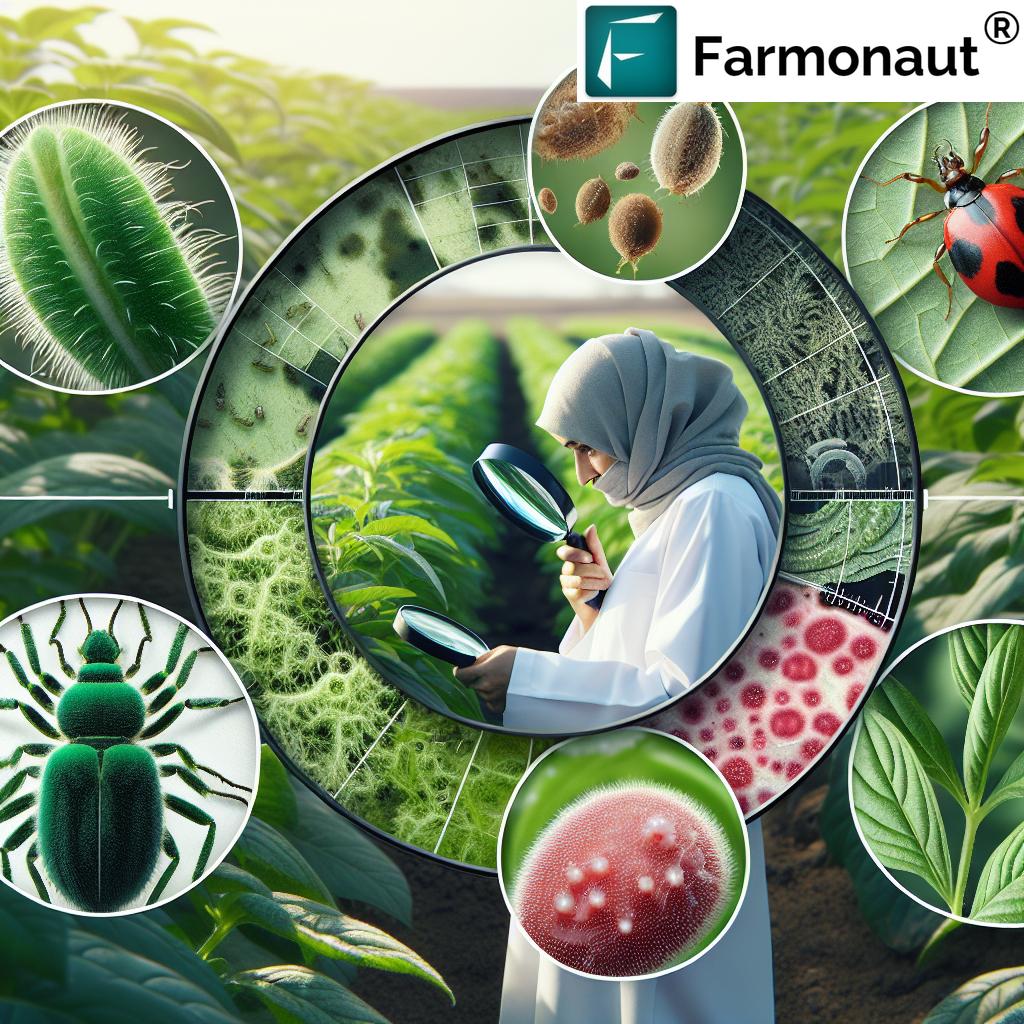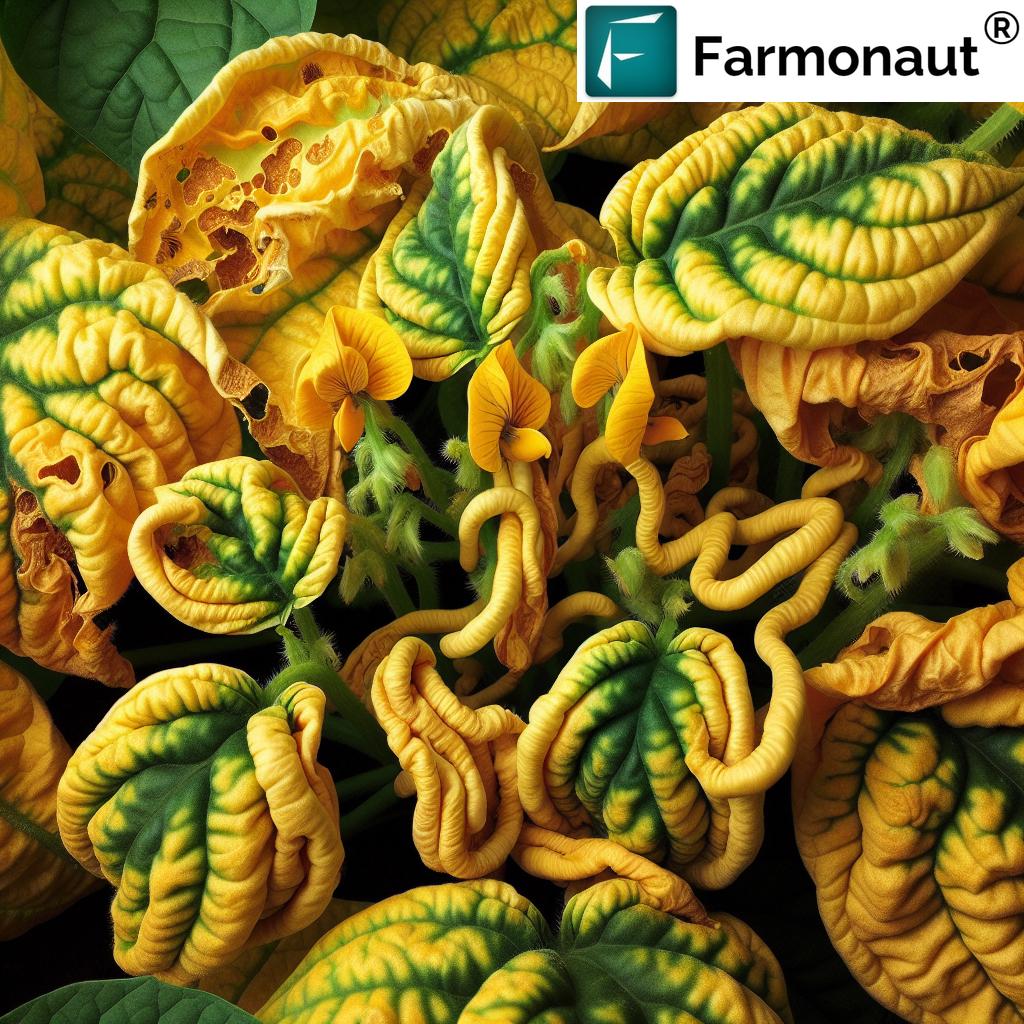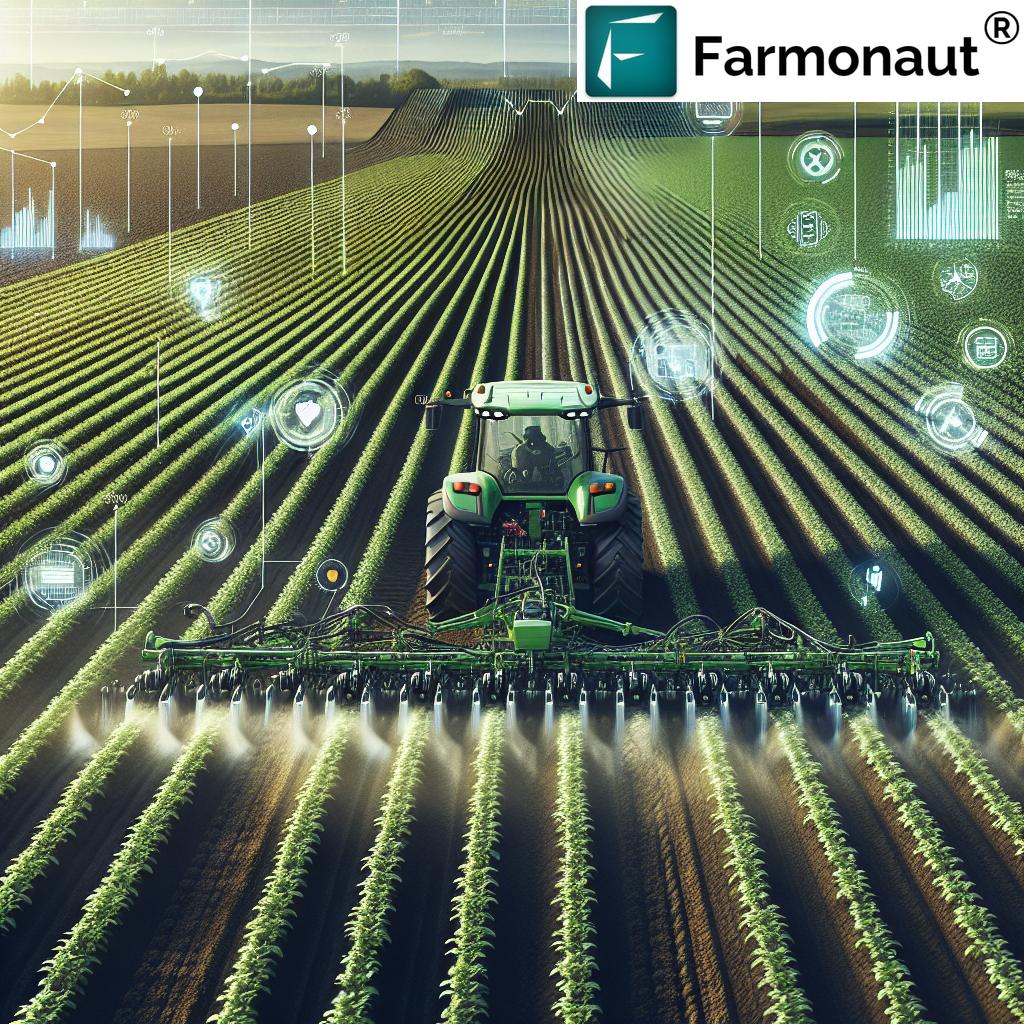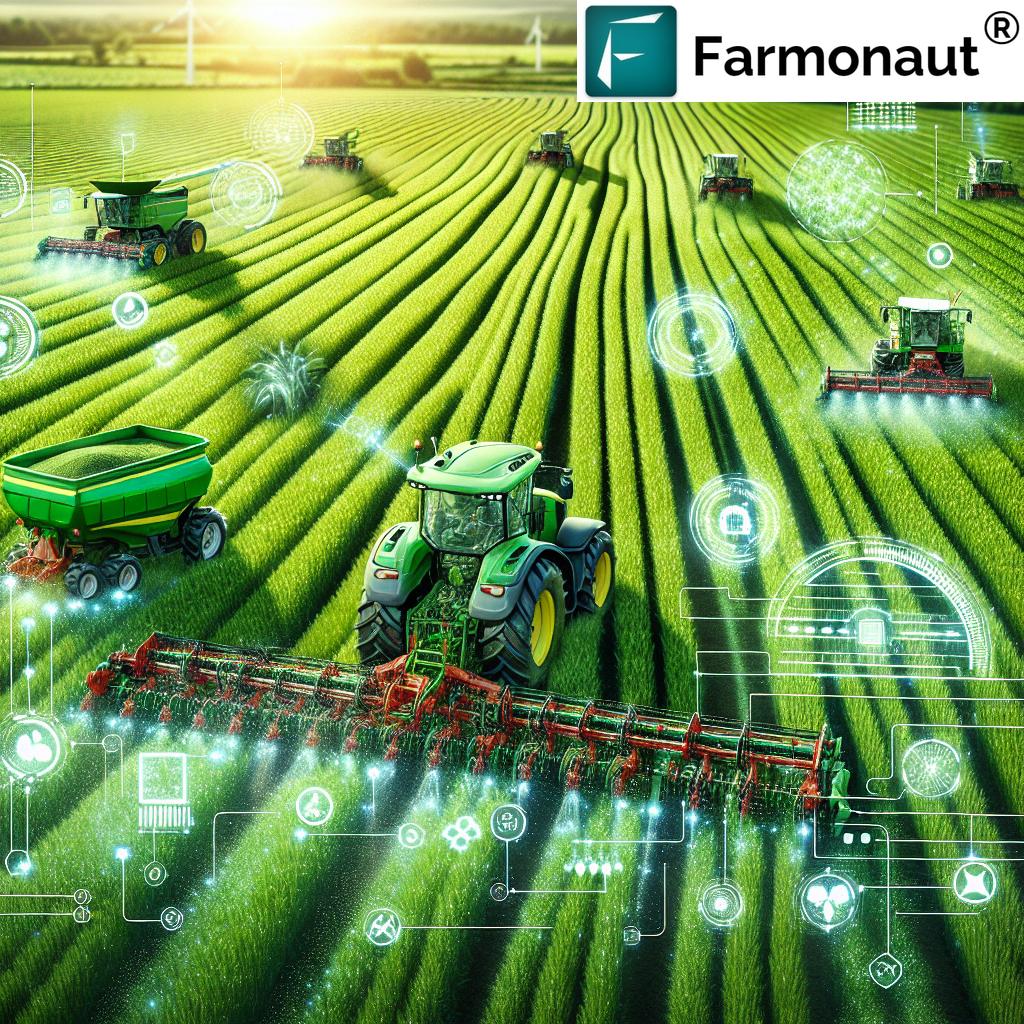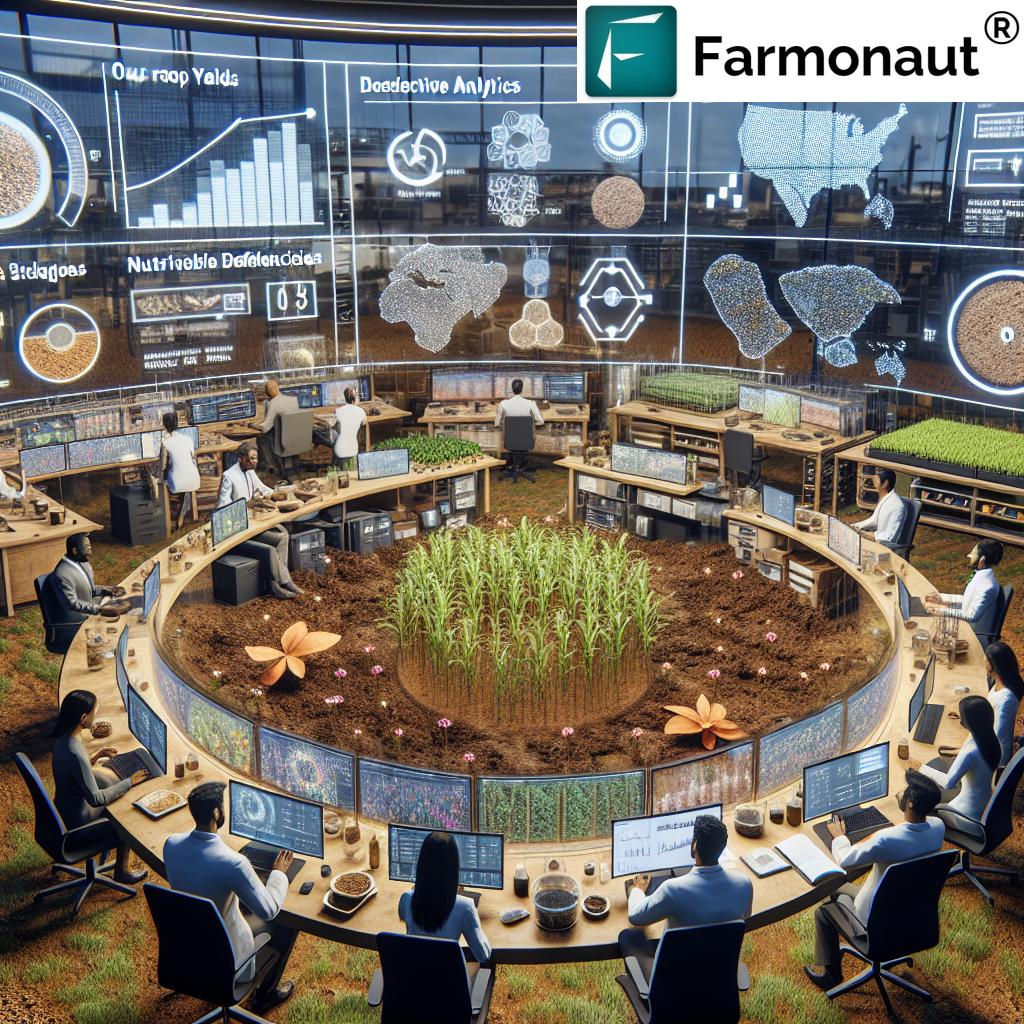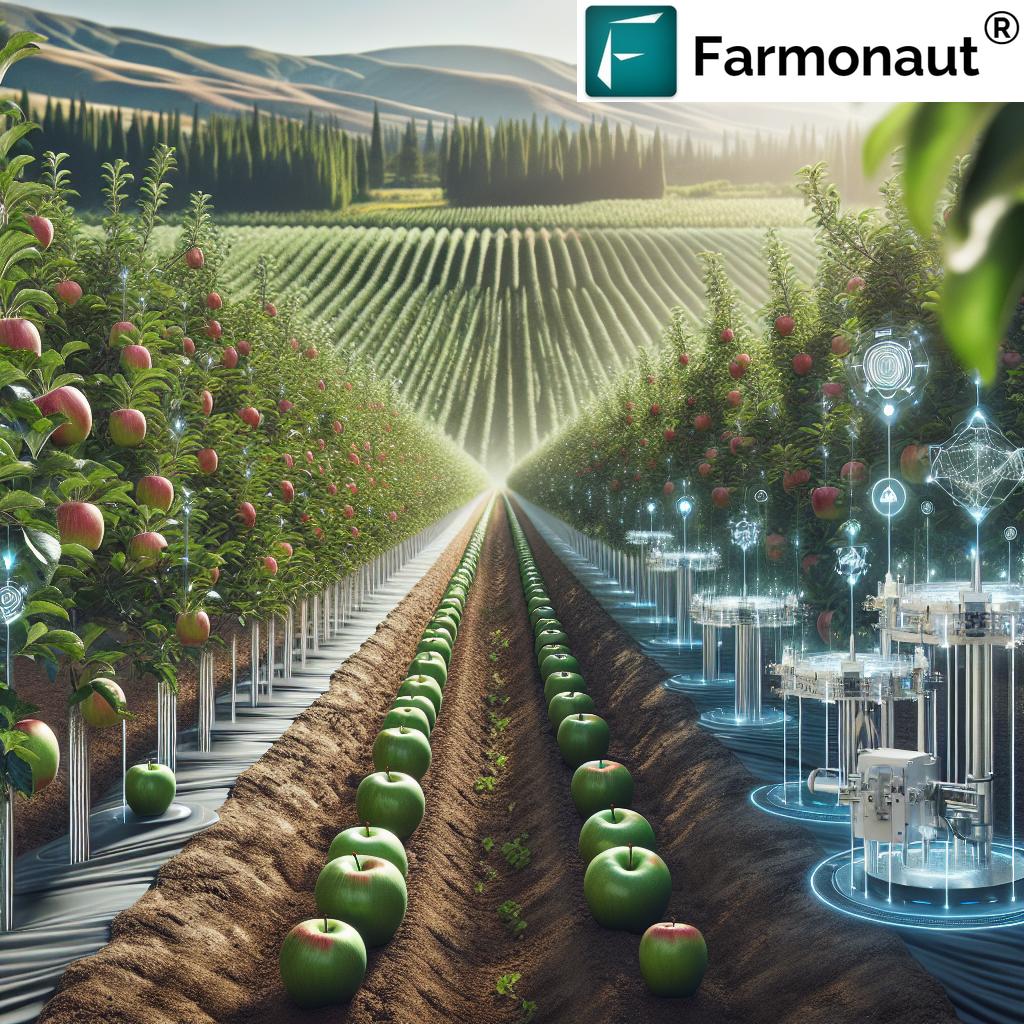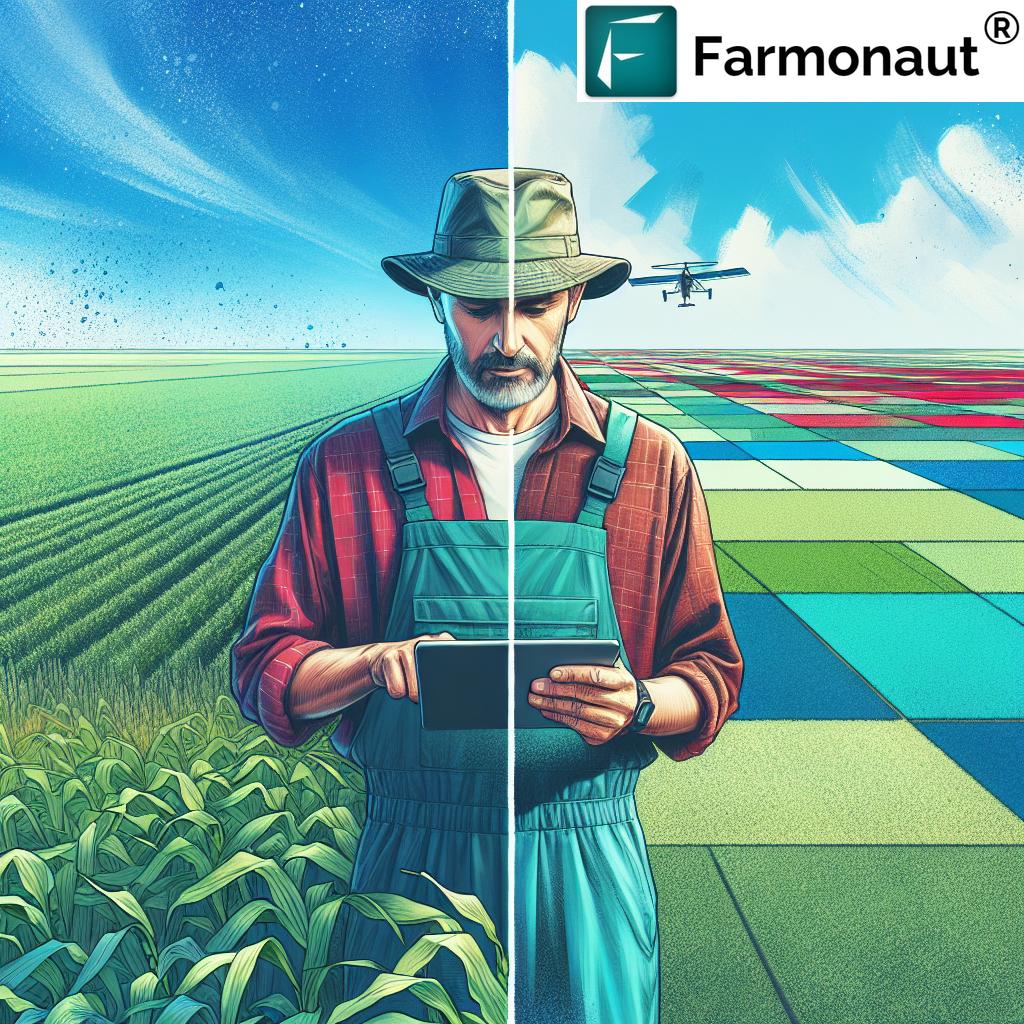
Maximizing Crop Health: Advanced Scouting and Monitoring Techniques for Pest, Disease, and Field Management in Modern Agriculture
In today’s rapidly evolving agricultural landscape, the importance of effective crop management cannot be overstated. As we face increasing challenges from climate change, pest pressures, and the need for sustainable farming practices, it’s crucial to employ advanced techniques for monitoring and maintaining crop health. At Farmonaut, we’re at the forefront of this agricultural revolution, leveraging cutting-edge technology to provide farmers with the tools they need to optimize their crop production and protect their investments.
The Evolution of Crop Scouting and Monitoring
Traditionally, crop scouting involved farmers physically walking through their fields, observing plants for signs of stress, pest infestation, or disease. While this method has served agriculture well for centuries, it has limitations in terms of coverage, frequency, and the ability to detect issues early enough for effective intervention. Today, we’re ushering in a new era of crop monitoring that combines traditional knowledge with advanced technology.
Satellite-Based Monitoring: A Game-Changer in Agriculture
One of the most significant advancements in crop monitoring is the use of satellite technology. At Farmonaut, we harness the power of satellite imagery to provide farmers with a comprehensive view of their fields. This technology allows for:
- Wide-area coverage: Satellite monitoring can cover vast areas of farmland quickly and efficiently.
- Frequent updates: We provide regular updates on crop health, allowing for timely interventions.
- Early detection: Our advanced algorithms can detect potential issues before they become visible to the naked eye.
- Data-driven decisions: Farmers can make informed decisions based on accurate, up-to-date information.
The Power of NDVI in Crop Health Assessment
One of the key metrics we use in our satellite monitoring is the Normalized Difference Vegetation Index (NDVI). NDVI is a powerful tool that measures the health and vigor of plants based on how they reflect different wavelengths of light. Here’s why NDVI is so valuable:
- It provides a quantitative measure of plant health.
- It can detect stress in plants before visible symptoms appear.
- It helps in identifying areas of a field that may need additional attention.
- It allows for precise application of inputs, reducing waste and environmental impact.
By integrating NDVI data into our monitoring systems, we provide farmers with an unparalleled view of their crop health across entire fields.
Comprehensive Pest and Disease Management
Pests and diseases are among the most significant threats to crop health and yield. Our advanced monitoring systems are designed to help farmers stay one step ahead of these challenges.
Early Detection of Pest Infestations
Detecting pest infestations early is crucial for effective management. Our satellite monitoring system can detect subtle changes in plant health that may indicate the presence of pests such as:
- Aphids: These small insects can quickly multiply and cause significant damage to crops.
- Spider mites: These tiny arachnids can cause stippling on leaves and reduce photosynthesis.
- Larvae: Various insect larvae can feed on crops, causing extensive damage if left unchecked.
By identifying these issues early, farmers can implement targeted pest control measures, reducing the need for broad-spectrum pesticides and minimizing environmental impact.
Disease Identification and Management
Plant diseases can spread rapidly and devastate entire crops if not managed promptly. Our system helps in the early identification of various diseases, including:
- Fungal infections
- Bacterial blights
- Viral diseases
By detecting changes in plant health indicative of disease, we enable farmers to take swift action, potentially saving entire fields from loss.
Optimizing Crop Growth Conditions
Successful crop production is about more than just pest and disease management. It’s about creating optimal conditions for plant growth and development. Our comprehensive monitoring system provides insights into various factors that affect crop health:
Soil Health and Nutrition
The foundation of healthy crops is healthy soil. Our monitoring system helps farmers maintain optimal soil conditions by:
- Tracking soil moisture levels
- Identifying areas of nutrient deficiency
- Monitoring soil pH levels
- Detecting erosion or compaction issues
With this information, farmers can make targeted interventions to improve soil health and promote robust crop growth.
Water Management
Effective water management is crucial for sustainable agriculture. Our system helps farmers optimize their water use by:
- Providing accurate soil moisture data
- Identifying areas of water stress or oversaturation
- Integrating weather forecasts for intelligent irrigation planning
This data-driven approach to water management not only improves crop health but also conserves this precious resource.
Temperature and Weather Monitoring
Temperature fluctuations and extreme weather events can significantly impact crop health. Our system integrates weather data to provide:
- Real-time temperature monitoring
- Frost and heat stress warnings
- Precipitation tracking
- Long-term weather trend analysis
This information allows farmers to take proactive measures to protect their crops from adverse weather conditions.
Crop-Specific Monitoring and Management
Different crops have different needs and face unique challenges. Our monitoring system is tailored to provide crop-specific insights for a wide range of plants, including:
Soybean Monitoring
Soybean crops require careful management to achieve optimal yields. Our system helps soybean farmers by:
- Tracking growth stages
- Monitoring for common soybean pests like aphids and spider mites
- Detecting nutrient deficiencies specific to soybean plants
- Providing harvest timing recommendations based on crop maturity
Potato Crop Management
Potato crops are susceptible to various pests and diseases. Our monitoring system assists potato farmers by:
- Early detection of potato blight and other common diseases
- Monitoring soil moisture to prevent tuber defects
- Tracking growth patterns for optimal harvest timing
- Identifying areas at risk for pest infestations like Colorado potato beetle
Fruit Tree Monitoring
Orchard management presents unique challenges. Our system supports fruit tree growers by:
- Monitoring overall tree health and vigor
- Detecting early signs of common fruit tree diseases
- Tracking fruit development stages
- Providing frost warnings to protect blossoms and developing fruit
The Future of Agriculture: Integrating Technology and Traditional Practices
While our advanced satellite monitoring system provides unprecedented insights into crop health and field conditions, we believe in integrating this technology with traditional agricultural knowledge and practices. The combination of high-tech monitoring and generations of farming wisdom creates a powerful approach to modern agriculture.
Complementing Traditional Scouting
Our satellite monitoring doesn’t replace traditional field scouting; it enhances it. By providing a comprehensive overview of field conditions, our system allows farmers to conduct more targeted and efficient in-person scouting. This integration of technology and hands-on observation leads to more effective crop management strategies.
Data-Driven Decision Making
With the wealth of data provided by our monitoring system, farmers can make more informed decisions about:
- Timing of planting and harvesting
- Application of fertilizers and pesticides
- Irrigation scheduling
- Crop rotation planning
This data-driven approach leads to more efficient use of resources, reduced environmental impact, and improved crop yields.
Sustainable Agriculture Practices
At Farmonaut, we’re committed to promoting sustainable agriculture. Our monitoring system supports environmentally friendly farming practices by:
- Reducing the need for broad-spectrum pesticides through early pest detection
- Optimizing water use to conserve this precious resource
- Minimizing fertilizer runoff by providing precise nutrient management data
- Supporting integrated pest management (IPM) strategies
By adopting these sustainable practices, farmers can not only improve their crop yields but also contribute to the long-term health of their land and the environment.
Empowering Farmers with Knowledge and Tools
Our mission at Farmonaut goes beyond just providing data. We aim to empower farmers with the knowledge and tools they need to succeed in an ever-changing agricultural landscape. Through our platform, farmers have access to:
- Educational resources on crop management best practices
- Community forums for sharing experiences and advice
- Expert consultations for complex agricultural challenges
- Regular updates on the latest advancements in agricultural technology
By fostering a community of informed and connected farmers, we’re helping to build a more resilient and sustainable agricultural future.
The Farmonaut Advantage: A Comparison
To illustrate the benefits of our satellite monitoring system, let’s compare it to traditional scouting methods:
| Monitoring Aspect | Traditional Method | Farmonaut Satellite System |
|---|---|---|
| Coverage Area | Limited to areas physically scouted | Entire fields and multiple properties simultaneously |
| Frequency | Weekly or bi-weekly at best | Daily updates possible |
| Pest/Disease Detection | Visual inspection, may miss early stages | Early detection through spectral analysis |
| NDVI Analysis | Not available | Comprehensive NDVI mapping of entire fields |
| Weather Integration | Separate systems required | Integrated weather data and forecasts |
| Time Efficiency | Time-consuming, labor-intensive | Rapid, automated data collection and analysis |
| Cost-Effectiveness | Labor costs for scouting | Scalable solution, cost-effective for large areas |
As this comparison shows, while traditional scouting methods have their place, the Farmonaut satellite system offers significant advantages in terms of coverage, frequency, and early detection capabilities.
Case Studies: Success Stories from the Field
While we don’t include specific case studies or success stories, it’s worth noting that farmers across various regions and crop types have reported significant benefits from using our satellite monitoring system. These benefits include:
- Increased crop yields
- Reduced pest and disease losses
- Improved water use efficiency
- More targeted and effective use of inputs
- Time and labor savings in field management
These outcomes demonstrate the real-world impact of integrating advanced monitoring technology into agricultural practices.
Getting Started with Farmonaut
Ready to revolutionize your approach to crop management? Getting started with Farmonaut is easy:
- Visit our website at https://farmonaut.com/app_redirect to create an account.
- Download our mobile app from the Google Play Store or the Apple App Store.
- Input your field locations and crop types.
- Start receiving regular updates and insights about your crops.
For developers interested in integrating our data into their own systems, check out our API documentation at https://farmonaut.com/farmonaut-satellite-weather-api-developer-docs/.
Pricing and Subscription Options
We offer flexible pricing options to suit farms of all sizes. Choose the plan that best fits your needs:
Frequently Asked Questions (FAQ)
Q: How often is satellite data updated?
A: Our satellite data is typically updated daily, weather permitting. Some features may have more frequent updates.
Q: Can Farmonaut detect specific pests or diseases?
A: While we can’t identify specific pests or pathogens, our system can detect changes in plant health that may indicate pest infestations or disease outbreaks, allowing for targeted investigation.
Q: Is Farmonaut suitable for small farms?
A: Absolutely! We offer plans suitable for farms of all sizes, from small family operations to large commercial enterprises.
Q: How accurate is the NDVI data?
A: Our NDVI data is highly accurate, with a resolution down to 10 meters. However, factors like cloud cover can affect data quality.
Q: Can Farmonaut integrate with other farm management software?
A: Yes, we offer API access that allows integration with many popular farm management platforms. Check our developer documentation for details.
Q: Is training provided on how to use the Farmonaut system?
A: We offer comprehensive tutorials within our app and website. Additionally, our support team is always available to assist with any questions.
Conclusion: Embracing the Future of Agriculture
As we face the challenges of feeding a growing global population while preserving our environment, the importance of efficient and sustainable agricultural practices cannot be overstated. At Farmonaut, we’re proud to be at the forefront of this agricultural revolution, providing farmers with the tools and insights they need to maximize crop health, optimize resource use, and increase yields.
By combining cutting-edge satellite technology with traditional agricultural knowledge, we’re helping to create a more resilient, productive, and sustainable farming future. Whether you’re managing a small family farm or overseeing vast agricultural operations, our comprehensive monitoring and management system can help you take your farming practices to the next level.
Join us in embracing the future of agriculture. With Farmonaut, you’ll have the power to make data-driven decisions, respond quickly to challenges, and cultivate healthier, more productive crops. Together, we can build a more sustainable and prosperous agricultural future for generations to come.
